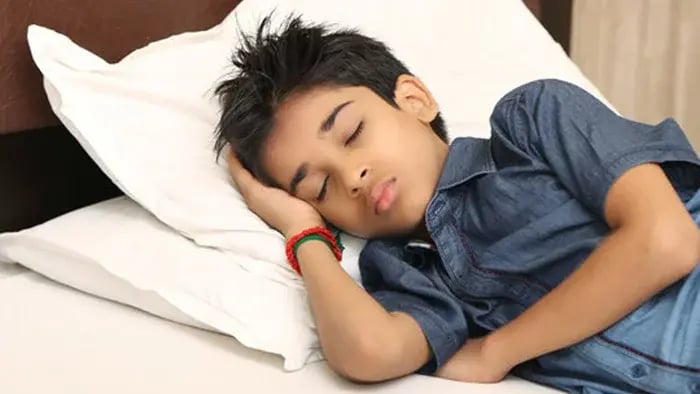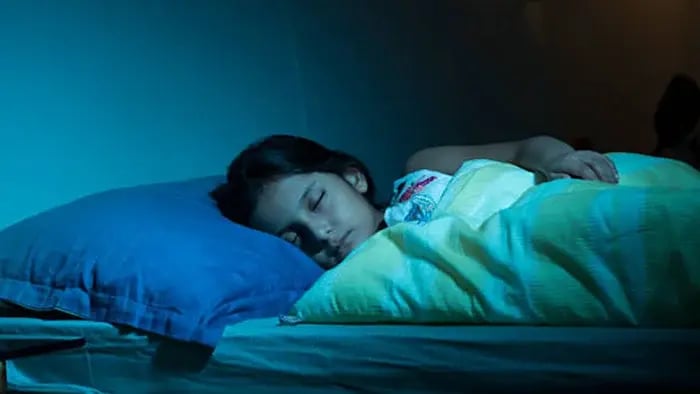Tarishi Shrivastava is a young writer who has covered a range of topics on children's health, including nutrition, fitness, sleep, and parent-child bonding. With a keen interest in simplifying wellness for parents, she brings a practical and engaging approach to her writing. Beyond work, she enjoys exploring new ideas, staying curious, and creating meaningful content.
- Consistent Bedtime Routine
- Limit Screen Time
- Create a Relaxing Environment
- Encourage Physical Activity
- Avoid Stimulants
- Mindfulness and Relaxation Techniques
- Settle Worries
- Healthy Sleep Habits
Introduction

Mindfulness can be a powerful tool to help kids wind down and improve sleep quality. As a parent, understanding how to incorporate mindfulness techniques into a bedtime routine can create relaxation and prepare them for a restful night. Mindfulness involves being fully present in the moment and calmly acknowledging thoughts and sensations without judgment. By practicing mindfulness before bed, children can release the day's stresses and ease into a peaceful state of mind conducive to sleep.
Simple techniques like deep breathing exercises can help slow down racing thoughts and relax the body. Encouraging children to focus on breathing, and taking slow, deep breaths in and out can signal to the body that it is time to unwind. Mindful body scans, where they mentally check in with each part of the body for tension and consciously relax each area, can further promote relaxation.
Incorporating gentle movements or stretches can also release physical tension. Engaging in quiet activities like reading a calming story or listening to soothing music can further improve the bedtime routine. By establishing these mindfulness practices consistently, parents can create a comforting bedtime ritual that supports kids' ability to relax, let go of worries, and enjoy a restful night's sleep.
Mindfulness And Sleep

Mindfulness promotes better sleep by calming the mind and body, making it easier to relax and fall asleep. By practicing mindfulness techniques before bed, such as deep breathing and body scans, children can release stress and reduce racing thoughts. This helps create a peaceful mental state conducive to falling asleep and experiencing deeper, more restorative rest throughout the night. Regular mindfulness practice also improves overall sleep quality by improving sleep patterns and reducing sleep disturbances, ultimately supporting children's physical and emotional well-being.
Why Is Adequest Sleep Important For Kids?
1. Physical Growth: During sleep, children's bodies release growth hormones that are essential for physical growth, muscle repair, and overall development.
2. Cognitive Development: Sleep plays a vital role in cognitive functions such as memory consolidation, problem-solving skills, and attention span. It improves learning and academic performance.
3. Emotional Regulation: Sufficient sleep helps children regulate emotions better, reducing irritability, mood swings, and emotional outbursts.
4. Immune Function: Sleep supports a healthy immune system, helping children fight off illnesses and infections more effectively.
5. Physical Health: Good sleep habits contribute to a healthy weight and reduce the risk of obesity by regulating hormones that control appetite and metabolism.
6. Behavioral Health: Inadequate sleep can lead to behavioral issues such as hyperactivity, impulsivity, and difficulty concentrating.
7. Mental Well-being: Quality sleep contributes to mental well-being by reducing stress and anxiety levels, promoting a positive mood, and improving resilience.
8. Overall Well-being: Consistent, restful sleep is essential for children to feel refreshed, alert, and ready to engage in daily activities, creating a happy and balanced life.
Techniques to Help Kids Sleep Peacefully

Consistent Bedtime Routine
Establish a regular bedtime routine that starts at least 30 minutes before the lights go out. Include calming activities such as reading a book, taking a warm bath, or practicing gentle yoga stretches. Consistency helps regulate the internal clock, signaling when it is time to wind down.
Limit Screen Time
Avoid screens, including TVs, smartphones, tablets, and computers, at least an hour before bedtime. The blue light emitted by screens can disrupt the production of melatonin, a hormone that regulates sleep, making it harder for kids to fall asleep.
Create a Relaxing Environment
Ensure the bedroom is conducive to sleep by making it quiet, dark, and cool. Use blackout curtains to block out light, white noise machines to mask distracting sounds, and adjust the room temperature to a comfortable level. Soft, cozy bedding and a supportive mattress also contribute to a relaxing sleep environment.
Encourage Physical Activity
Promote regular physical activity during the day, ideally earlier in the afternoon. Exercise helps children expend excess energy, making it easier for them to relax and fall asleep at night. Outdoor play, sports, or family walks are excellent options to encourage physical tiredness.
Avoid Stimulants
Limit or avoid caffeinated beverages such as soda, energy drinks, and tea in the afternoon and evening. Caffeine can interfere with children's ability to fall asleep and stay asleep, leading to restless nights.
Mindfulness and Relaxation Techniques
Teach relaxation techniques like deep breathing exercises, progressive muscle relaxation, or guided imagery. These practices help calm the mind and body, reducing stress and anxiety that can interfere with sleep. Spend a few minutes practicing these techniques together before bedtime.
Settle Worries
Create a worry journal or dedicate time before bed for children to talk about any concerns or anxieties they may have. This allows them to express feelings and problem-solve, reducing bedtime worries that can keep them awake.
Healthy Sleep Habits
Establish a consistent sleep schedule, with consistent bedtimes and wake-up times even on weekends. Ensure children are getting the recommended amount of sleep according to the age group, which typically ranges from 9 to 12 hours for school-age children.
Conclusion

Establishing a peaceful bedtime routine and creating a sleep-friendly environment are key to helping kids sleep well. Consistency, relaxation techniques, limiting screen time, and promoting physical activity contribute to restful nights. By prioritizing healthy sleep habits, parents set the stage for children to wake up refreshed and ready for the day.
The views expressed are that of the expert alone.
The information provided in this content is for informational purposes only and should not be considered a substitute for professional medical advice, diagnosis, or treatment. Always seek the advice of your physician or another qualified healthcare provider before making any significant changes to your diet, exercise, or medication routines.
References
https://www.headspace.com/sleep/better-sleep-kids
https://www.ekhartyoga.com/articles/wellbeing/4-yoga-techniques-to-help-your-kids-sleep
https://www.ekhartyoga.com/articles/wellbeing/4-yoga-techniques-to-help-your-kids-slee










